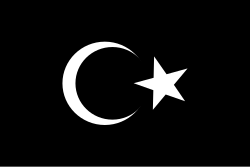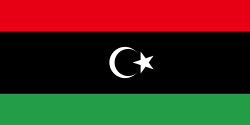Libyjské království
| Libyjské království al-Mamlakah al-Lībiyya المملكة الليبية
| |||||||||||
geografie
| |||||||||||
rozloha: | 1 759 530 km² | ||||||||||
| obyvatelstvo | |||||||||||
počet obyvatel: | 1 091 830 z roku 1954 | ||||||||||
národnostní složení: | |||||||||||
| státní útvar | |||||||||||
měna: | libyjská libra | ||||||||||
vznik: | |||||||||||
zánik: | |||||||||||
| státní útvary a území | |||||||||||
| |||||||||||
Libyjské království (arabsky المملكة الليبية), v letech 1951–1963 oficiálním názvem Spojené království Libye, vzniklo po vyhlášení nezávislosti 24. prosince 1951 a trvalo až do 1. září 1969, kdy skupina armádních důstojníků v čele s Muammarem Kaddáfím po státním převratu svrhla krále Idrise I. a ustavili Libyjskou arabskou republiku.
Historie
Po druhé světové válce obsadili tehdejší italskou kolonii Libyi Spojené království a Francie. Ty si kolonii rozdělily podle historických regionů, takže Britům připadlo do správy Tripolsko a Kyrenaika, zatímco Francouzům Fezzán. Toto rozdělení bylo navíc potvrzeno OSN v roce 1947 jako poručenská území, v témže roce se navíc Itálie vzdala nároků na území Libye. 21. listopadu 1949 přijalo Valné shromáždění OSN rezoluci, podle které by se měla Libye stát nezávislou před 1. lednem 1952.
A tak bylo dne 24. prosince 1951 vyhlášena nezávislost Libye jako dědičné království. Novým králem se stal Idris I. (z rodu Senussi) do té doby emír Kyrenaiky a také Tripolska. Celá země byla federací tří historických regionů (bývalých kolonií) Tripolska, Kyrenaiky a Fezzánu. Celá země měla také dvě hlavní města a to Tripolis a Benghází (Tripolis hlavním městem zůstal po roce 1969).
Dva roky po vyhlášení nezávislosti v roce 1953 se Libye připojila k Lize arabských států.
V roce 1955 začal průzkum ložisek ropy a první ropná pole byla objevena v roce 1959. První export byl zahájen teprve až v roce 1963. Objevení ropy pomohlo transformovat libyjskou ekonomiku.
Dne 25. dubna 1963 byl federativní systém vlády zrušen a s tímto byl také změněn název země na království Libye, aby odrážel změny ústavy.
1. září 1969, skupina vojenských důstojníků vedených Muammarem Kaddáfím provedla státní převrat (puč) proti králi Idrisovi I., zatímco on byl v Turecku na lékařském léčení. Revolucionáři zatkli náčelníka generálního štábu a šéfa bezpečnosti v království. Nová revoluční vláda následně zrušila monarchii a ustanovila republiku. Po svržení monarchie byla země oficiálně přejmenována na Libyjskou arabskou republiku.
Odkazy
Reference
- ↑ Libyjské království mělo 2 hlavní města, ale postavení důležitějšího hlavního města měl Tripolis a tato role mu zůstala dodnes
Související články
- Muhammad as-Senussi – současný pretendent libyjského trůnu
- Dějiny Libye
- Seznam libyjských panovníků
- Následnictví libyjského trůnu
- Fezzán
- Tripolsko
- Kyrenaika
Externí odkazy
 Obrázky, zvuky či videa k tématu Libyjské království na Wikimedia Commons
Obrázky, zvuky či videa k tématu Libyjské království na Wikimedia Commons - Ústava libyjského království
Média použitá na této stránce
Traditional banner of the Senussi and flag of Cyrenaica from 1949-1951.
Autor: Пакко, Licence: CC BY-SA 3.0
Emblem of the Kingdom of Libya, known as the "Crown of Libya", after a design used during 1952-1969.
The constitution of the Kingdom of Libya of 1952 in article 7 describes the flag, but not the emblem. No official description is available at present (due to the restrictions placed on government archives since the military coup of 1969), and the design is reconstructed from many variants in shape and color schemes. The 24dec1951.com website conducted research into the design as represented in official government sources of 1952-1969, and describes the emblem as follows:
- Top Crown adorned with a white Crescent and five-pointed star at its summit, at which five visible side frames originating from a ring at the base converge. The star studded base and frame contain a velvet black head cover like object.
- The Top Crown is supported at its base by two beautiful plantar designs; in the form of three intertwined C and S scroll shapes.
- Two massive “Shoulder” frames contain the body of the crown from the right and left [...]. Each side is a complex formation of intertwined branches in the shape of an S Curve, which is essentially two back-to-back C scrolls; the larger one of which terminates in a large beautiful spiral at the top. [...]
- The background color of the large interior below the Top Crown can be white or transparent, although this is not evident in the picture of the Libyan pound. The background color of the center region surrounding the large white Crescent and Star is black as in the center stripe of the Libyan flag.
- A white ring with thin black borders, surrounds the center large white Crescent and Star.
- Nine five-pointed white stars surround the center ring.
- Large white crescent.
- Five pointed star located well above the perimeter of the crescent. This differs from the flag, which places the star at the extremities of the crescent.
- A Center Crown, seated above the ring containing the Crescent and Star. Its design is identical to the Top Crown, except for being smaller in size.
- Plantar/ floral ornamentation similar to #2 above, providing variation and connectivity to the base.
- At the base, an elegant design that resembles a document scroll with a ring tie at its center. It is noted that the color scheme of the crown is most likely white for the stars and crescents, black and white (or transparent) for spaces, and gold for the crowns and frames. [...]
Flag of the Libyan Arab Republic (1969-1972)








